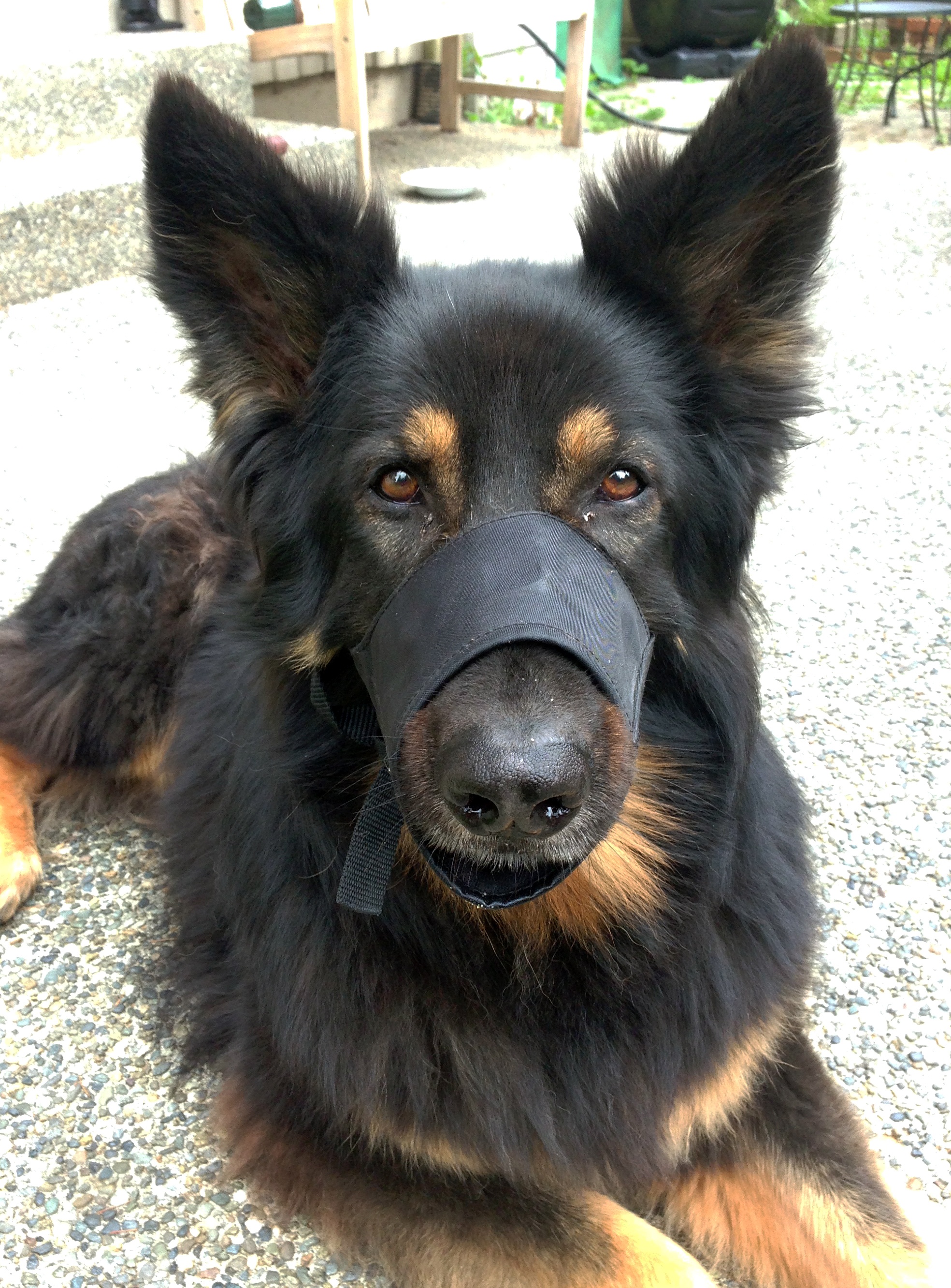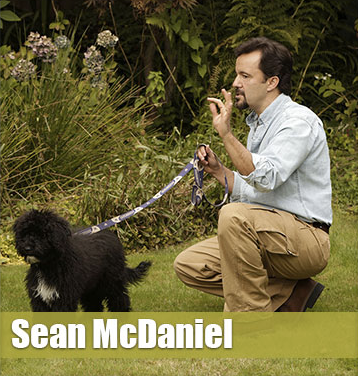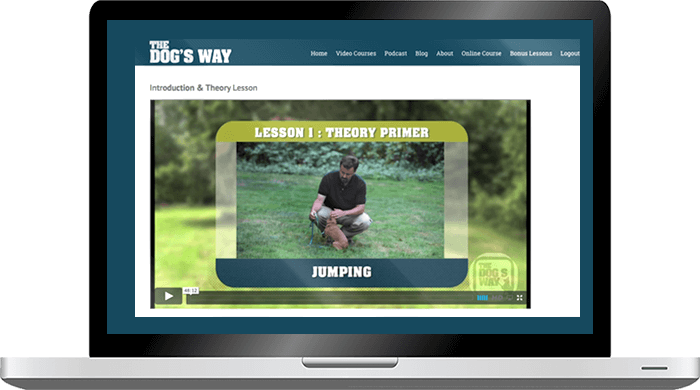How Can a Muzzle Help Happy, Well-Adjusted Dogs?

Many of my clients have dogs that fall into the “reactive” dog category. With dogs like that, at some point, we almost always do some work with their dog wearing a muzzle when we get closer to triggers. I use a muzzle in training periodically for three reasons.
MUZZLES IN TRAINING
1. In many cases, the muzzle brings a dog’s reactions down a peg or two. This allows us to bring a dog into situations that they may not have been exposed to for some time.
2. It serves as a little insurance policy for owners. It’s often comforting knowing they won’t have to be paying a medical bill to sew up another dog’s ear or a forearm, if the experiment near other animals or people goes worse than expected.
3. The safety of a muzzle allows other people and their dogs to act more normally around a reactive dog in training, and offers better, safer, training scenarios than we’d be able to find without the muzzle.
MUZZLE CONDITIONING AS A WAY OF PREPARING YOUR DOG FOR A WORST CASE SCENARIO
Even when dogs don’t obviously need to use a muzzle in training though, I do recommend everyone do some muzzle conditioning with their dog simply out of preparation. Every veterinarian has a set of nylon muzzles in their office. Vets use in these in the event they have to examine a dog with severe injuries, or for when they have an extra anxious or fearful dog in their office. This prudent and cautious veterinary policy isn’t really an overreaction either. I’ve seen pretty gregarious dogs flash their teeth when someone goes to examine a broken bone or a partially ripped out dew claw. It’s safest for medical staff, and for you, to have your dog wear a muzzle during an exam of this kind.
The reason I recommend doing this conditioning with your happy, well-adjusted dog is that I want that “worst case scenario” to go as well as it can go. If your dog is injured, they’re already stressed out. This isn’t really the ideal time to introduce new “training equipment”! If, on the other hand, your dog has been conditioned, and accustomed, to having a muzzle put on their face, and has the ability to leave it on for several minutes while you do some obedience work, handling exercises and perhaps even some nail clipping and brushing, then your dog won’t have to suffer that additional stress of having that “weird thing” put over their face while they’re experiencing severe pain in a traumatic medical event.
HOW TO CONDITION YOUR DOG TO A MUZZLE … USING FOOD TREATS! (GASP!)
That’s right – I said it … using food treats! For those of you who have followed much of my training, either in person, via the video training course, or in the podcast, you’ll know food isn’t a primary training tool in my practice. Though many of you have probably also heard me say, “There are definitely times that I use food in training, but I just don’t want the core of the relationship based on handing out food.” Well, this is one of those times! The example of conditioning a dog to accept more and more restriction via the muzzle is a great scenario to use food reinforced conditioning.
HERE’ S WHAT YOU’LL NEED:
- A properly sized nylon muzzle (available at virtually every pet store)
- Some high value treats (“high value” usually means oily and smelly)
- Your leash and training collar (which ever collar you use to train or walk with – If you use a harness, then just attach the leash to the regular flat collar that you have your dog’s tags on)
SIZING A NYLON MUZZLE
If you have a fancy cloth measuring tape, use that to measure around the girth of your dog’s snout, about half way between the eyes and the nose. Note that your dog’s mouth should be closed when you take the measurement. Add 15% to the direct measurement. (We want a small amount of space in the fit of the muzzle so your dog can open their mouth very slightly)
NOTE: If you don’t have a cloth measuring tape, you can use a shoe lace. Find the length with the lace and then hold the lace up to a ruler to determine the length.
WARNING: Please be aware that panting cannot normally occur with this type of muzzle. If a muzzle is required during exercise, or during very hot weather when panting is a necessity, please use a basket type muzzle (I recommend a Baskerville soft cage muzzle).
CONDITIONING PROCESS (think of doing this process prior to every meal)
Phase 1: Getting used to the muzzle being near or on his face
- Familiarize yourself with the muzzle and the plastic clip on the strap– take your best guess as to the length you’ll need the strap to be. You can quickly cinch it to the right length later in the conditioning process.
- Spend the first few days simply exposing your dog to the muzzle (let your dog sniff it and have it around prior to every feeding)
- Then cut up some hot dog or some equally high value food item in small pieces (you’re only going to use this around the muzzle conditioning work)
- Give your dog a couple of pieces of the food directly out of your hand without the muzzle present, and then give a piece of food through the mouth hole of the muzzle by holding the muzzle over your treat hand and feeding the hot dog through the muzzle in a way that requires your dog to put their nose into the muzzle to get the piece of food from your hand.
- Work up to feeding several treats in a row to get their snout to stay in the muzzle longer
- When your dog’s snout goes into the muzzle, be sure to “mark” that behavior with a marker word like “good” or “yes”. This is precisely where you’d click a clicker if you’re using that sort of training.
Phase 2: Progress to fastening the strap
- After a few days conditioning your dog to have their face in the muzzle, put the leash and collar on before every feeding and prior to your muzzle conditioning (like you’re going for a walk)
- The goal in this section is to fasten the back strap. After one of the times you slide the muzzle over your dog’s snout, and feed 3-4 treats, fasten the back strap and then grab your leash. Your dog will probably paw at the muzzle. Pop the leash straight up and say “leave it”, and then verbally mark the “leaving of it” and offer a treat if they stop messing with the muzzle for a second or two.
- Wait for a couple of seconds, and if your dog leaves the muzzle alone, mark that with your marker word “good” again, and then give a treat or two.
- Then quickly unclick the muzzle strap and remove it – give your dog 5-6 treats after removing it and then feed their meal.
- Do this step for a few days until your dog tolerates the muzzle for 30 seconds or so. You may motivate keeping the muzzle on by giving 5-6 treats over the 30 seconds, if your dog doesn’t mess with the muzzle.
Phase 3: Work up to more and more time with the muzzle on prior to feeding
- Once you get to this stage, put the muzzle on your dog, and go out the front door with your dog on leash like it’s a walk, however, only head out the front or back door for a few steps. Immediately, go right back inside and have your dog wait for 30 seconds to two minutes before feeding. You may offer some treats over that time if they leave the muzzle alone.
- NOTE: You’ll have to pop that leash up and say “leave it” with each transition that happens as your dog will try to get the muzzle off with each new step in the process. For example, while walking around, going through a door etc. Stay consistent with the message that they’re not allowed to mess with it. Also, be just as consistent with verbally “marking” (precisely saying ‘good!’ as the decision to leave it alone occurs) and rewarding with the hot dog when your dog does new things with the muzzle on (like taking several steps out the door without messing with it).
- After your dog can walk around the house, through the doorway and back and spend 2-3 minutes with the muzzle on, you’re ready to progress with handling or training exercises with the muzzle on for a few more minutes.
- Have the goal to work up to a comfortable 10-15 minutes with the muzzle on with various distractions and handling exercises being done without protest of the muzzle. Remember, reward frequently, but methodically move towards an intermittent reward schedule so your dog looks to expect half a dozen treats or so, throughout a 15 minute muzzle training session.
There you go, hopefully that will help in getting your dog used to wearing a muzzle.
All the best,
Sean
Is Treat Based Training Not Working For Your Dog?
We’ve got you covered with The Dog’s Way Online Video Training Course
Have you been told your dog isn’t trainable because food treats don’t seem to work as a motivator? We get calls all the time with dog owners telling us this very thing. Sean McDaniel offers an option for those sorts of dogs. The Dog’s Way Online Video Training Course is a step-by-step solution for dogs that aren’t food motivated enough to go through treat-based training. Progress through the online video course at your own pace and in the comfort of your own home. Watch Sean as he works through problems and progressions with real dogs and their owners and learn from their mistakes and challenges as you go.
And by the way, if you find that your dog is food motivated but only responds when you have food in your hand – this course will help you too!
To learn more about The Dog’s Way Training Online Video Training Course or to register for the course, click the button below or CLICK HERE to contact Sean!

About the Author: Sean
I’ve been training people and dogs in Seattle for the last decade and a half. My main focus when working with clients every week in one-on-one, private lessons is to help people learn to get their dogs to a functional level so that they can actually enjoy spending time every day with their dog instead of stressing about their dog’s behavior issues.
Affiliate Program
Make money by referring people to the video course!
. . . . .

About Sean
I’ve been training people and dogs in Seattle for the last decade and a half. My main focus when working with clients every week in one-on-one, private lessons is to help people learn to get their dogs to a functional level so that they can actually enjoy spending time every day with their dog instead of stressing about their dog’s behavior issues.
Ask Sean a question!
If we use your question in the show, Sean will send you a coupon code for free access to the online video course!
If you have a question you’d like me to respond to on the show (and you want to hear yourself on a future episode) leave me a voice mail! 1 (844) 364-7929 or email me here.

